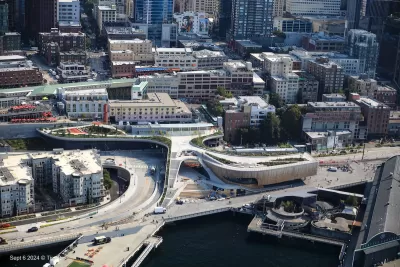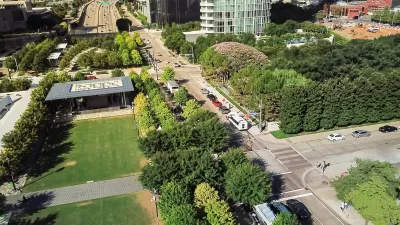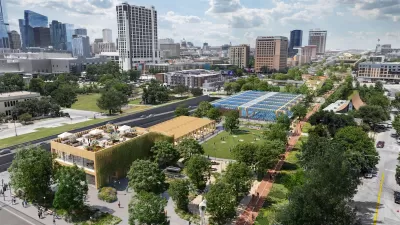The elevated park and event space replaces part of the demolished Alaskan Way Viaduct, connecting the city’s famous Pike Place Market to the waterfront.

The centerpiece of a major revamp of Seattle’s waterfront opened this month, with city officials cutting the ribbon on Overlook Walk, a new overpass and park space connecting Pike Place Market and the waterfront over Alaskan Way.
“One of the last major upgrades planned as part of the 15-year project to decide how to remake the central waterfront after the demolition of the Alaskan Way Viaduct, the Overlook Walk is one of the most ambitious public works projects completed by the City of Seattle in decades,” explains Ryan Packer in The Urbanist.
According to Packer, Overlook Walk is designed primarily as a park and gathering space rather than a transportation connection, with parts of it set to close at 10pm every night. “While the Overlook Walk likely won’t make many people’s trips much faster, it will create the type of intuitive connection between some of the city’s most trafficked areas that simply hasn’t existed before, at least not since the elevated Alaskan Way highway dividing the city opened in 1953.”
Packer describes various elements of the Walk, including new playgrounds and stadium-style steps ready for concerts or events. “While many people have mixed feelings about the overall waterfront redevelopment, especially the new Elliott Way roadway up into Belltown and the incredibly wide section of Alaskan Way near Colman Dock, the Overlook Walk represents its high point, in more ways than one, and is poised to become one of the city’s most iconic new spaces.”
FULL STORY: Overlook Walk Finally Opens as the New Seattle Waterfront’s Centerpiece

Alabama: Trump Terminates Settlements for Black Communities Harmed By Raw Sewage
Trump deemed the landmark civil rights agreement “illegal DEI and environmental justice policy.”

Planetizen Federal Action Tracker
A weekly monitor of how Trump’s orders and actions are impacting planners and planning in America.

The 120 Year Old Tiny Home Villages That Sheltered San Francisco’s Earthquake Refugees
More than a century ago, San Francisco mobilized to house thousands of residents displaced by the 1906 earthquake. Could their strategy offer a model for the present?

LA’s Tree Emergency Goes Beyond Vandalism
After a vandal destroyed dozens of downtown LA trees, Mayor Karen Bass vowed to replace them. Days later, she slashed the city’s tree budget.

Sacramento Leads Nation With Bus-Mounted Bike Lane Enforcement Cameras
The city is the first to use its bus-mounted traffic enforcement system to cite drivers who park or drive in bike lanes.

Seattle Voters Approve Social Housing Referendum
Voters approved a corporate tax to fund the city’s housing authority despite an opposition campaign funded by Amazon and Microsoft.
Urban Design for Planners 1: Software Tools
This six-course series explores essential urban design concepts using open source software and equips planners with the tools they need to participate fully in the urban design process.
Planning for Universal Design
Learn the tools for implementing Universal Design in planning regulations.
Ada County Highway District
Clanton & Associates, Inc.
Jessamine County Fiscal Court
Institute for Housing and Urban Development Studies (IHS)
City of Grandview
Harvard GSD Executive Education
Toledo-Lucas County Plan Commissions
Salt Lake City
NYU Wagner Graduate School of Public Service





























